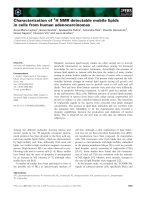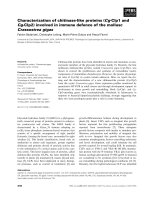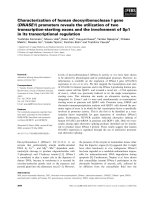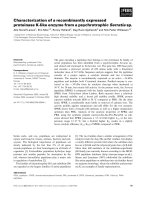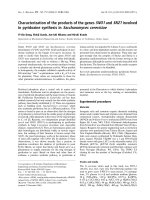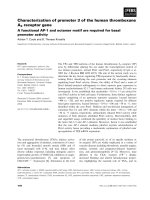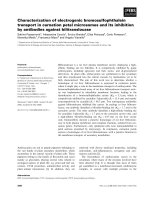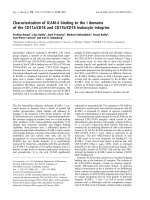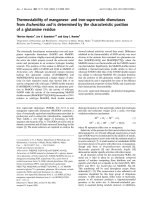Tài liệu Báo cáo Y học: Characterization of an omega-class glutathione S-transferase from Schistosoma mansoni with glutaredoxin-like dehydroascorbate reductase and thiol transferase activities pptx
Bạn đang xem bản rút gọn của tài liệu. Xem và tải ngay bản đầy đủ của tài liệu tại đây (407.81 KB, 10 trang )
Characterization of an omega-class glutathione
S
-transferase
from
Schistosoma mansoni
with glutaredoxin-like
dehydroascorbate reductase and thiol transferase activities
Javier Girardini
1,
*, Alejandro Amirante
2,†
, Khalid Zemzoumi
1
and Esteban Serra
1
1
Instituto de Biologı
´
a Molecular y Celular de Rosario, IBR-CONICET, Facultad de Ciencias Bioquı
´
micas y Farmace
´
uticas, UNR;
and
2
Facultad de Odontologı
´
a, UNR, Rorario, Argentina
Glutathione S-transferases (EC 2.5.1.18) (GSTs), are a
family of multifunctional enzymes present in all living
organisms whose main function is the detoxification of
electrophilic compounds. GSTs are considered the most
prominent detoxifying class II enzymes in helminths. We
describe here the characterization of novel dehydroascorbate
reductase and thiol transferase activities that reside in the
human parasite Schistosoma mansoni GSTx. Protein
sequence analysis of this parasite product showed lower
identity to known GSTs. However, phylogenic analysis
placed SmGSTx among the recently described omega class
GSTs (GSTO1-1). We report here that SmGSTO protein is a
28-kDa polypeptide, detected in all life stages of the parasite,
being highly expressed in adult worms. Like other omega
class GSTs, SmGSTO showed very low activity toward
classical GSTs substrates as 1-chloro-2,4-dinitrobenzene,
and no binding affinity to glutathione–agarose matrix but
showed some biochemical characteristics related with thio-
redoxins/glutaredoxins. Interestingly, SmGSTO was able to
bind S-hexyl glutathione matrix and displayed significant
glutathione-dependent dehydroascorbate reductase and
thiol transferase enzymatic activities.
Keywords: glutathione S-transferase; dehydroascorbate
reductase; thiol transferase; Schistosoma.
Glutathione S-transferases (GSTs, EC 2.5.1.18) constitute a
family of multifunctional enzymes that mainly catalyze the
nucleophilic attack of reduced glutathione (GSH) to a wide
variety of electrophilic endogenous and exogenous com-
pounds. GSTs are found in all living organisms tested to
date, present as unique enzymes in lower organisms and as a
large number of tissue-specific isoforms in more complex
species like mammals [1,2].
The expression level of GSTs is modulated by many
compounds including carcinogens, drugs and oxidative-
stress metabolites [1]. Several additional functions were
attributed to GSTs including the transport of hydrophobic
ligands, binding to bilirubin and carcinogens [3,4], the
isomerization of maleylacetoacetate and the regulation of
stress kinases and apoptosis [5,6].
Based on their sequence structure, catalytic activitiy,
immunogenicity, substrate specificity and sensitivity to
inhibitors, the mammalian GSTs form six evolutionary
distinct classes termed alpha, kappa, mu, pi, sigma, and zeta
[1,7,8]. A new class of the GST superfamily, designated GST
omega (GSTO) in accordance with the established human
GST nomenclature convention [9], has been recently
characterized in humans on the basis of structural data
[10]. This new enzyme (GSTO1-1) has similar functional
characteristics with previously described proteins in rats [11]
and mouse [12]. Although the mammalian GSTO has low
sequence similarity to other known GSTs, its crystallo-
graphic structure showed a GST fold composed of an
N-terminal glutathione-binding domain and a C-terminal
domain composed entirely of a-helices. In contrast, unlike
other GSTs, GSTO has an active site cysteine that is able to
form a disulfide bond with GSH and exhibits glutathione-
dependent thiol transferase (TTase) and dehydroascorbate
reductase (DHA) activities, reminiscent of thioredoxin (Trx)
and glutaredoxin (Grx) enzymes [10]. Recent studies have
shown new additional functions for human GSTO including
monomethylarsonic acid (MMA) reductase activity and the
modulation of ryanodine calcium channels [13,14]. A
particular member of the GST superfamily, designated
Tc52, exhibiting GSH-dependent TTase activity, has been
characterized in the human causative agent of Chagas’
disease, Trypanosoma cruzi [15,16]. Further studies have
shown that Tc52 is essential for the parasite development
and is involved in the immunomodulatory processes asso-
ciated with Chagas’ disease [17–20].
Correspondence to E. Serra, Instituto de Biologı
´
a Molecular y
Celular de Rosario, IBR-CONICET, Facultad de Ciencias
Bioquı
´
micas y Farmace
´
uticas, UNR, Suipacha 531 CP 2000,
Rorario, Argentina. Fax: 54 3414390465, Tel.: 54 3414370008,
E-mail:
Abbreviations: CDNB, 1-chloro-2,4-dinitrobenzene; DHA, dehydro-
ascorbate reductase; DCNB, 1,2-dichloro-4-nitrobenzene; Grx,
glutaredoxin; GSH, glutathione; GST, glutathione S-transferase;
GSTO, GST omega; HEDS, hydroxyethyl disulfide; MMA, mono-
methylarsonic acid; Trx, thioredoxin; TTase, thiol transferase.
Enzyme: glutathione S-transferase (EC 2.5.1.18).
Note: nucleotide sequence data are available in the GeneBank database
under the accession number AF484940.
*Note: These authors contributed equally to this work.
Present address:Hoˆ pital N-Dame, Allergy, M4211-K, 1560 rue
sherbrooke Est, Montre
´
al, QC, H2L 4M1, Canada
(Received 8 July 2002, revised 3 September 2002,
accepted 11 September 2002)
Eur. J. Biochem. 269, 5512–5521 (2002) Ó FEBS 2002 doi:10.1046/j.1432-1033.2002.03254.x
At least five GST activities have been described in the
human parasite Schistosoma mansoni (SmGST-1 to
SmGST-5). SmGST-5 has been characterized as an
unstable enzyme that may be involved in the conjugation
of epoxide substrates and dichlorovos, the active form of
the anti-schistosomal drug metrifonate, but no corres-
ponding parasite gene has been cloned to date [21–23].
Two members of SmGSTs, 28-kDa Sm28GST and
26-kDa Sm26GST, have been cloned and were found to
correspond to the previously reported SmGST-1, -2, -3
and -4 isoenzymes, respectively [22,24]. Although DHA
activity was first described in plants several years ago, and
then in mammals, insects and protozoans, little is known
about nonvertebrate GSH-dependent DHA proteins at
the molecular level.
We report here the characterization of a new member
of the GST superfamily from S. mansoni. When compared
with other GSTs, S. mansoni protein showed a limited
sequence identity with omega-class GSTs. Additional
phylogenic analysis, including known GSTs classes and
S. mansoni GSTs, allowed us to place the new parasite
product among the newly identified GSTO class, and the
previously characterized Sm28GST and Sm26GST as
mu- and sigma-class, respectively. Additional evidence
placed the S. mansoni protein among the omega class of
GSTs, as the recombinant parasite protein (a) did not
have significant affinity for glutathione, but bound
strongly to S-hexyl glutathione matrix; (b) exhibited low
activity towards the classical GST substrate 1-chloro-2,4-
dinitrobenzene (CDNB); and (c) showed significant GSH-
dependent TTase and DHA activities. The data presented
here provide the first evidence for a potential new ascorbic
pathway within S. mansoni.
EXPERIMENTAL PROCEDURES
Materials
Reduced glutathione, oxidized glutathione, S-hexyl gluta-
thione, 1-chloro-2,4-dinitrobenzene, 1,2 dichloro-4-nitro-
benzene, cibacron blue 3GA, and t-butyl hydroquinone,
were obtained from Sigma; 7-chloro-4-nitrobenzo-2-oxa-
1,3-diazole, ethacrynic acid, p-nitrobenzyl chloride,
dehydroascorbate, bromosulfophthalein, Evan’s blue, hem-
atine, and p-chloranil were obtained from ICN; hydroxy-
ethyl disulfide (HEDS) and vinylene trithiocarbonate was
obtained from Aldrich.
EST identification and cDNA isolation
The S. mansoni EST data base search was performed using
the t
BLAST
n version of blast program [25] with the T. cruzi
Tc52 amino acid sequence as query. An EST encoding an
unknown protein was obtained (GeneBank accession num-
ber AI975843). A 549-bp fragment was amplified by PCR
using oligonucleotides GSTX1: 5¢- GTTGTCGACAAA
CATCTCAACTAG-3 and GSTX3: 5¢-GTAAGTGTGG
GAATAAGATCAAATC from adult S. mansoni reverse-
transcribed RNA. The product of the PCR was sequenced
and used as probe to screen an adult worm S. mansoni
lambda gt10 cDNA library by conventional methods [26].
Southern blot analysis was performed using S. mansoni
cercariae purified DNA as described [26].
Alignments and phylogenetic analysis
of
S. mansoni
GSTs
Sm26GST, Sm28GST and SmGSTO amino acid sequences
were aligned manually on the alignment provided by
L. Jermiin (see [10]). From the original alignment used by
Board et al. [10] eight not clearly class-defined sequences
were avoided. A phylogenetic tree was obtained by
maximum likelihood analysis of all the sites in the above-
mentioned alignment. The data was analyzed using the JTT-
F substitution model [27], and local bootstrap probabilities
were estimated for the internal branches using the
PROTML
program [28]. More than one analysis was performed by
using different input order of the sequences. Each analysis
involved two steps: stepwise addition and nearest neighbor
interchanges. The most likely tree was obtained by using the
test of Kishino and Hasegawa [29]. All calculations were
performed using the
MOLPHY
2.3 molecular phylogenetics
programs package [28].
Expression and purification of recombinant SmGSTO
Recombinant SmGSTO was expressed in Escherichia coli
and purified by two separate methods using either the
pQE30 vector (Qiagen) and nickel agarose affinity chroma-
tography, or the pT7-7 vector [30] and S-hexyl glutathione
affinity chromatography. To produce N-terminal 6 · His
tag fused SmGST, the SmGSTO cDNA was amplified
by polymerase chain reaction (sense primer GSTX2:
5¢-AAGGATCCATGCACCTTAAACGAAATGACC-3¢;
antisense primer odTSalI: 5¢-AAGTCGACTTTTTTTTTT
TTTTTTTTTS-3¢) and was inserted between the BamHI
and SalI sites of the bacterial expression vector pQE30
(Qiagen), the cloned vector was transformed into BL21
[DE3] cells (Novagen, Milwaukee, WI, USA). Briefly, a seed
culture of the transformed cells was grown to D
600
of
0.4–0.6, scaled up, grown again to the same density, induced
with IPTG (0.5 l
M
), and grown for a further 3 h at 30 °C.
His-tagged SmGSTO product was purified on nickel
agarose as described by manufacturers (Qiagen). The
enzyme was eluted with 250 m
M
imidazole, 50 m
M
potas-
sium phosphate, pH 7.6, and exhaustively dialyzed against
the same buffer to remove imidazole before storage at
80 °C in 50% glycerol. Recombinant SmGSTO was also
expressed from it’s own methionine initiation codon.
Briefly, SmGSTO cDNA was amplified by polymerase
chain reaction (sense primer GSTX4: 5¢-AAACATATGAT
GCACCTTAAACGAAATGACC-3¢; antisense primer
odTSalI) and cloned between the NdeIandSalIsitesof
the expression vector pT7-7. Protein was purified from
soluble extracts on S-hexyl glutathione agarose (Sigma) as
previously described [31]. The enzyme was eluted with 5 m
M
S-hexyl glutathione, 50 m
M
Hepes, pH 8, and dialyzed
against 50 m
M
Hepes, pH 8.0, before storage. Purification
yield approximately 500 lg of protein per milliliter of
S-hexyl glutathione agarose. In all cases, protein purity was
determined by SDS/PAGE and protein concentration was
measured by bicinchoninic acid method following manu-
facturers indications (Sigma). Antiserum against the puri-
fied protein was raised in rabbits using standard
immunization protocols.
Glutathione and S-hexyl glutathione affinity assays were
performed in batch. Briefly, 20 lL of 50% resuspended
Ó FEBS 2002 Omega-class GST from Schistosoma mansoni (Eur. J. Biochem. 269) 5513
resin was centrifuged and the supernatant was eliminated.
Ten microliters of 1 mgÆmL
)1
purified enzyme was added to
the same tube and incubated in ice with gentle agitation.
After 30 min the supernatant was recovered by centrifuga-
tion. The resin was washed four times with 250 lLof
50 m
M
Hepes, pH 8.0, and eluted by adding 10 lLofthe
same buffer containing 5 m
M
GSH, GSSG or S-hexyl GSH.
Ten microliters of the original protein, binding assay
supernatant and eluate were analyzed by SDS/PAGE.
Expression of SmGSTO along the parasite life cycle
Total proteins were prepared as follows: S. mansoni schist-
osomule or sporocysts were resuspended in extraction buffer
(100 m
M
Tris, 3 m
M
EDTA, 1 m
M
phenylmethylsulfonyl
fluoride, 2.5 lgÆmL
)1
leupeptin, 4 lgÆmL
)1
pepstatin A);
adults or cercariae were first homogenized with liquid
nitrogen and then resuspended in extraction buffer. The
extracts were homogenized by pulses of 1 min at 25%
amplitude and centrifuged at 10 000 g for 20 min at 4 °C.
The soluble fraction was ultracentrifuged at 105 000 g for
30 min at 4 °C and the supernatants were used for assays.
One hundred micrograms protein from each extract were
separated by SDS/PAGE, electroblotted to a nitrocellulose
membrane (Amersham Pharmacia). Western blot experi-
ments were carried out according to standard techniques.
Ten micrograms of DNAse I-treated total RNA from
S. mansoni miracidia, sporocyst, cercariae and adult worm
were reverse transcribed by using 100 U of SuperScript
TM
reverse transcriptase (Life Technologies) in 50 lLof
supplied reaction buffer. PCRs were performed on 1 lL
of each reverse transcription reaction and resolved by
agarose gel electrophoresis. Primers used were: GSTX1/
GSTX3 for SmGSTO and TUB3 (5¢-GAAGTGGAT
ACGAGGATAAGGTACCAG-3¢)/TUB4 (TGGAACTT
ATCGTCAACTTTTCCATCC-3¢)forS. mansoni a-tubu-
lin. SmGSTO amplification bands were quantified by using
GelPro and normalized by comparing to a-tubulin ampli-
fication products.
Enzyme assays
Enzymatic activity towards a range of substrates and
inhibitors was determined as described [32]. Thiol trans-
ferase activity was measured according to Axelsson et al.
[33] using HEDS as substrate. The reaction mixture
contained 0.2 m
M
NADPH, 0.5 m
M
GSH, 50 m
M
phos-
phate buffer, 0.5 units of glutathione reductase and an
aliquot of the protein solution. The reaction was initiated by
the addition of 2 m
M
of HEDS at 30 °C and followed by
340 nm absorption decrease. Absorption coefficient used
for NADPH oxidation at 340 nm was 6.22 m
M
)1
Æcm
)1
.
Glutathione-dependent dehydroascorbate reductase activity
was determined by following the dehydroascorbate (DHA)
reduction spectrophotometrically at 265 nm. The standard
reaction mixture contained 50 m
M
phosphate buffer, pH 8,
1m
M
GSH, and was started with the addition of 0.25 m
M
DHA after a 1 min preincubation [34].
Construction of a homology model of SmGSTO
SmGSTO structure was built using the human GSTO 1–1
structure as template in the SWISS-MODEL modeling
environment and structure accuracy was assayed by
WHAT
CHECK
tool in the same environment [35]. Briefly, structurally
driven alignments were performed using SmGSTO sequence.
Best alignment, obtained based on GSTO1-1, was refined
and used to obtain an optimized model. The WhatCheck tool
(from the
WHAT IF
package program) was used to estimate
accuracy of the structure obtained. Parameters taken into
account were: Ramachandran plot appearance Z-score, chi-
1/chi-2/Z-score, packing quality Z-score and RMS Z-scores
( />RESULTS
SmGSTO DNA and protein sequence
BLAST search of the S. mansoni EST database with the
complete sequence of Tc52 revealed a clone (EST AI975843)
with around 25% sequence identity with the GST-like
domain of the T. cruzi protein. A fragment of 549 bp was
amplified by PCR using specific primers, designed based on
the EST sequence, and cDNA from S. mansoni adult
worms. The amplified fragment was sequenced and used as
probe to screen an adult worm cDNA library. After three
rounds of hybridization, two independent clones were
purified and sequenced. The sequences obtained were
identical in both clones and corresponded to a cDNA of
934 bp including an open reading frame encoding for a 241
amino acid polypeptide, with a predicted molecular mass of
27.6 kDa (Fig. 1). Sequence identity ranging from 18 to
25% was obtained with human GST-theta, mouse p28, rat
DHA, human GSTO 1-1, as well as with several plant
DHAs and non characterized GST-like proteins. In all
cases, the most conserved amino acids were localized in the
N-terminal domain of SmGSTO. The best hit obtained
(E ¼ 8.1e
)11
) when searched at HMM motifs databases
was the pfam glutathione S-transferase N-terminal domain
(GST-Nter, PF02996).
In order to determine whether our sequence belongs to
the GST omega class, a phylogenetic analysis using the
maximum-likelihood approach was carried out. To achieve
this, our sequence, as well as Sm28GST and Sm26GST
sequences, were included in a multiple-sequence alignment
similar to that previously used to characterize human omega
class GST [10]. The tree in Fig. 2 is the most likely tree
obtained by neighbor-interchange analysis of 2000 likeli-
hood trees, and shows the eight families previously described
by Board et al. [10] The tree grouped the new SmGST with
human, rat, mouse and Caenorhabditis elegans omega GSTs
as well as two plant GST-like sequences already proposed to
belong to the omega class by Board et al. [10] leading us to
name it SmGSTO. Concerning the two other S. mansoni
GSTs, Sm26GST grouped within mu-class GSTs with a
high local bootstrap value and Sm28GST remains in a
nondefined position between sigma and pi classes.
A Southern blot analysis was performed in order to
ascertain that the cloned sequence belonged to the parasite
and was not due to an artifact, and also to examine the copy
number of SmGSTO genes in the parasite genome. Cerca-
riae genomic DNA was digested with several restriction
enzymes and hybridized with radiolabeled SmGSTO probe
(Fig. 3). The pattern of hybridization obtained suggested
that one copy of SmGSTO exists per haploid genome in
S. mansoni.
5514 J. Girardini et al. (Eur. J. Biochem. 269) Ó FEBS 2002
Fig. 1. Nucleotide and deduced amino acid
sequences of SmGSTO 1. The codon corres-
ponding to the initial methionine is
underlined.
Fig. 2. Unrooted phylogeny showing the most likely relationship between class representative GSTs and S. mansoni GST amino acid sequences. Branch
lengths are proportional to estimates of evolutionary change. The number associated with each internal branch is the local bootstrap probability
that is an indicator of confidence. The sequences are (species name; GenBank
TM
accession number): Schistosoma omega (Schistosoma mansoni,
AF484940), nematode omega (Caenorhabditis elegans, L23651), mouse omega (Mus musculus, U80819), rat omega (Rattus rattus, AB008807),
human omega (Homo sapiens, AF212303), soybean heat-shock protein (HsPr) (Glycine max, M20363), potato GST (Solanum tuberosum, J03679),
nematode zeta (Caenorhabditis elegans, Z66560), human zeta (Homo sapiens, NM_001513), carnation zeta (Dianthus caryophyllus, M64268), mouse
theta (Mus musculus, U48419), human theta (Homo sapiens, NM_000854), blowfly delta (L. cuprina, L23126), house fly delta (Musca domestica,
X61302), fruit fly Delta (Drosophila melanogaster, X14233), Arabidopsis phi (Arabidopsis thaliana, D17672), Petunia phi (Petunia hybrida, Y07721),
mouse mu (Mus musculus, J03952), human mu (Homo sapiens, NM_000848), chicken mu (Gallus gallus, X58248), rat Pi (Rattus norvegicus,
L29427), human pi (Homo sapiens, NM_000852), rat sigma (Rattus norvegicus, D82071), human sigma (Homo sapiens, D82073), squid2 sigma
(Ommastrephens sloanei, M36938), squid1 sigma (O. sloanei, M36937), Schistosoma 28 kDa (Schistosoma mansoni, S71584), human alpha (Homo
sapiens, NM_000846), mouse alpha (Mus musculus, M73483), and chicken alpha (Gallus gallus, L15386), Schistosoma 26 kDa (Schistosoma
mansoni, M31106).
Ó FEBS 2002 Omega-class GST from Schistosoma mansoni (Eur. J. Biochem. 269) 5515
GSH binding affinity of recombinant SmGSTO
Recombinant SmGSTO was first produced as a fusion to a
histidine-tag and purified in one step using an Ni
2+
nitrilotriacetic acid resin (Fig. 4A). There are some discrep-
ancies in the literature about the ability of omega class GSTs
to bind different glutathione-coupled matrixes. To deter-
mine whether SmGSTO was able to bind glutathione
agarose, we have used the purified enzyme in batch assays.
As showed in Fig. 4B,C, His-tagged SmGSTO was not able
to bind to agarose-coupled glutathione, but was able to bind
to S-hexyl glutathione agarose and was recovered after
elution with S-hexyl glutathione, as was already described
for Tc52 [16]. In order to ascertain our observation and to
rule out the (possibility that the lack of binding of SmGSTO
to glutathione was neither due to the presence of the His-tag
sequence nor to a deletion in the parasite protein sequence,
we constructed a second plasmid which directed the
production of SmGSTO from its own methionine initiation
codon, lacking the His-tag. In this way, the recombinant
SmGSTO could be purified using an S-hexyl glutathione–
agarose matrix (Fig. 4D). Furthermore, batch experiments
performed with this protein determined that S-hexyl
glutathione agarose-bound SmGSTO was not eluted by
reduced nor by oxidized glutathione (Fig. 4E). These results
suggested that SmGSTO has a low affinity to glutathione,
which coincides with the K
m
value obtained for GSH in
kinetic experiments (see below).
Expression of SmGSTO
The recombinant SmGSTO was used to produce polyclonal
antibodies in immunized rabbits. Expression of SmGSTO
along the parasite life cycle was analyzed by Western blot.
In cercariae, sporocysts, schistosomule and adult worms, a
immunoreactive band was observed with a calculated
molecular weight of nearly 28 kDa (Fig. 5A). However,
higher SmGSTO levels were observed in sporocysts (para-
sitic stage of the intermediate host Biomphalaria glabrata)
and adult worms (parasitic stage of human) than in others
stages. Expression of SmGSTO was also studied at the
transcriptional level by RT-PCR using cDNA prepared
from miracidia, sporocysts, cercariae and adult worms
(Fig. 5B). A unique amplification product of the 549 bp
expected size was observed in all reactions. The intensity of
the amplified products was compared after normalization
using a-tubulin cDNA as internal control. Relative values
showed as a bar graphic determine that SmGSTO tran-
scription is higher in sporocysts and adult worms in
comparison with cercariae and miracidia. This results are
in agreement with those obtained by Western blot. Taken
together, these results suggested that SmGSTO is expressed
more in parasitic stages than in free living stages during the
S. mansoni life cycle.
Characterization of recombinant SmGSTO enzymatic
activity
Recombinant GSTO was used to assay its enzymatic
activity. Results of substrate specificity are shown in
Table 1. SmGSTO showed a negligible activity against
CDNB and ethacrynic acid and no measurable activity
against other GST substrates like 1,2-dichloro-4-nitroben-
zene (DCNB), 7-chloro-4-nitrobenzo-2-oxa-1,3-diazole;
p-nitrobenzyl chloride, vinylene thiocarbonate, t-butyl
hydroquinone and p-chloranil. In contrast, SmGSTO
showed DHA and HEDS-measured TTase activities.
Kinetic parameters were obtained for DHA and TTase
activities. SmGSTO showed a K
m
¼ 0.23 m
M
for HEDS
and a K
m
¼ 0.32 m
M
for GSH in the TTase reaction. These
values were similar to those obtained for the same reaction
for glutaredoxins from several origins [36]. When kinetic
parameters were calculated for DHA activity, a
K
m
¼ 2.3 m
M
for DHA was obtained. Graphical analysis
of the data obtained for GSH concentrations between
300 l
M
and 4 m
M
in a Lineweaver–Burk plot resulted
reproducibly in a K
m
value of 6.5 m
M
. As GSH concentra-
tions >4 m
M
could not be tested, we prefer to give a K
m
of
>4 m
M
for GSH in this reaction. Even though differences
in K
m
values for GSH in the two assayed reactions were
obtained, it was clear that a K
m
lower than 0.32 m
M
could
not be reached. Finally, SmGSTO showed differential
sensitivity to several GST inhibitors tested (Table 2).
Among them, it is interesting to note the inhibitory activity
of CDNB which is considered as a classical GST substrate.
Specific activity was first measured for both reactions in
standard conditions using a phosphate buffer pH 7.6 [33].
However, when the pH profile for SmGSTO activity was
carried out, optimal activities were recorded at pH 8.0 and
pH 8.6 when phosphate buffer or Tris/HCl buffer were
used, respectively (Fig. 6). A similar optimal pH profile was
recently reported for Plasmodium falciparum glutaredoxin 1
activity [37].
Construction of a homology model of SmGSTO
SmGSTO structure was built using the human GSTO 1–1
structure as template in the SWISS-MODEL modeling
Fig. 3. Southern blot analysis of SmGST. DNA from S. mansoni
cercaria (10 lg) digested with different restriction enzymes was
hybridized with the coding region of SmGST-O cDNA radiolabeled by
a random primer.
5516 J. Girardini et al. (Eur. J. Biochem. 269) Ó FEBS 2002
environment [35]. Structure accuracy was assayed by
WhatCheck tool in the same environment. As can be
observed in Fig. 7(A), only N-terminal SmGSTO domain
structure could be predicted with accuracy. The program
was unable to model the C-terminal domain of SmGSTO
due to the low rate of identity between the two proteins in
this region. However, as the active sites of the GSTO1-1 are
located at the N-terminal domain, several shared structural
features with SmGSTO could be pointed out. Residues
S(86), E(85), V(72), K(59) and C(32) which contact GSH in
GSTO 1–1 correspond to S(79), E(78), V(65), K(52) and
C(25) in SmGSTO, and were predicted to be placed in the
same spatial orientation (Fig. 7B).
DISCUSSION
We report here the characterization of a new member of the
GST superfamily from the human blood fluke S. mansoni.
BLAST
searches for sequence similarities showed that the
cloned parasite gene has sequence homology to members of
the recently discovered omega class of GSTs [10], and was
Fig. 4. Expression and purification of His-tagged SmGSTO and native SmGSTO. (A) SDS/PAGE analysis of His-tagged SmGST purified on
nickel-agarose. Lane 1, 50 lg soluble extract of BL21 (ED3) expressing His-tagged SmGSTO. Lane 2, 5 lg purified His-tagged SmGSTO. (B)
Batch analysis of His-tagged SmGSTO to GSH-agarose. Lane 1, protein used in the binding step. Lane 2, supernatant of the binding-step. Lane 3,
GSH eluted fraction. (C) Batch analysis of His-tagged SmGSTO to S-hexyl glutathione-agarose. Lane 1, protein used in the binding step. Lane 2,
supernatant of the binding-step. Lane 3, S-hexyl glutathione eluted fraction. (D) SDS/PAGE analysis of recombinant native GST purified on
S-hexyl glutathione-agarose. Lane 1, 50 lg soluble extract of BL21 (ED3) expressing native SmGSTO. Lane 2, 5 lg purified SmGSTO. (E) Elution
of S-hexyl glutathione agarose-bound SmGSTO by GSH, GSSG or S-hexyl glutathione. In all cases: Lane 1, protein used in the binding step. Lane
2, supernatant of the binding-step. Lane 3, eluted fraction. Compound used to elute in each case are indicated in the figure.
Fig. 5. Expression of SmGSTO in S. mansoni. (A) Immunoblotting
analysis of parasite extracts. Each lane contains total protein (50 lg)
from cercariae (lane 1), schistosomula (lane 2), sporocysts (lane 3), and
adult worms (lane 4) electroblotted and immunodetected by a-SmG-
STO serum. (B) RT-PCR analysis of different S. mansoni stages.
Reverse-transcribed RNA from miracidia (lane 1), sporocysts (lane 2),
cercariae (lane 3) and adult worms (lane 4) were amplified using
SmGSTO and a-tubulin specific primers as indicated in experimental
section.
Ó FEBS 2002 Omega-class GST from Schistosoma mansoni (Eur. J. Biochem. 269) 5517
referred here as SmGST omega (SmGSTO). In addition,
sequence alignment of SmGSTO with representative
sequences from the recently reported GSTO class or from
the EST data base highlights similarities, but also significant
differences. In all cases, the most conserved amino acids
were localized in the N-terminal domain of the SmGSTO
protein. However, the remaining regions of SmGSTO
presented significant divergences from the known GSTO,
at the primary structure level. Indeed, the GSTO class
represents a particular class of the GST superfamily which
possesses specific structural features, such as an active site
cysteine that is able to form a disulfide bond with GSH, a
novel domain formed by the proximity of a specific
N-terminal extension to the C-terminus and a large H-site,
as well as the ability to catalyze the GSH-dependent
reduction of dehydroascorbate [10].
We further undertook a phylogenetic protein sequence
analysis to ascertain whether the SmGSTO was a divergent
member of the GSTO class. The deduced SmGSTO protein
sequence was used in a phylogenic analysis using the
maximum-likelihood approach. Two other previously char-
acterized S. mansoni GSTs, Sm26GST and Sm28GST, were
amongst the GST proteins included in this study. The most
likely tree obtained showed the eight proposed GST families
[7,8]. The tree grouped the new cloned schistosome protein
as a divergent member of the GSTO class. We could also
place the Sm26GST among the Mu-class. Even if position
of Sm28GST was not well defined in the tree, the fact that
Sm28GST has a prostaglandin D2 synthetase activity,
typical of the sigma class of GSTs, strongly suggest that it
belongs to this group (J. F. Trottein, Institut Pasteur de
Lille, France, personal communication). All S. mansoni
GSTs showed particularly long branches when compared
with those obtained for free living invertebrates GSTs. This
high rate of evolution for Schistosoma GSTs was already
reported [38]. The same abnormality was also observed
when the phylogenetic analysis of S. mansoni nuclear
receptors was performed [39]. The proposed explanation
for this observation is that the human parasites of Schisto-
soma genus were subjected during evolution to a biased
selection pressure due to host biochemical characteristics,
including the immune and endocrine systems. The host
pressure resulted in abnormally divergent parasite sequences
as shown for GSTs and nuclear receptors of the parasite, or
by abnormally host-parasite converged sequences as was
reported for the tropomyosins of S. mansoni and its
intermediate host Biomphalaria glabrata [40].
SmGSTO expression in the different life forms of
S. mansoni was performed by RT-PCR and Western blot.
The results obtained support the higher expression of
SmGSTO observed in S. mansoni parasitic life stages rather
than in free-living life stages, suggesting that this protein
may play a role in the survival of the parasite within the
host. An increased expression during cercariae transforma-
tion to mature adults in mammalian host was already
described as a general feature for detoxifying enzymes in
Schistosoma [41–43]. Immunohistochemical analysis of
human tissues confirmed a widespread expression of
GSTO1-1, suggesting that it has important biological
functions. Specific expression of GSTO1-1 was localized in
the nuclei and in nuclear membranes of many cell types [44].
However, no putative nuclear localization signals could be
found within GSTO1-1 or SmGSTO. Nuclear localization
Table 1. Substrate specificities of recombinant SmGSTO. Activity for
each substrate was determined in standard conditions. ND, not
detected.
Substrate
Specific activity
(lmolÆmin
)1
Æmg
)1
)
1,2-Dichloro-4-nitrobenzene ND
1-Chloro-2,4-dinitrobenzene 0.02
7-Chloro-4-nitrobenzo-2-oxa-
1,3-diazole
ND
Ethacrynic acid 0.02
p-Nitrobenzyl chloride ND
Vinylene trithiocarbonate ND
t-Butyl hydroquinone ND
p-Chloranil ND
Dehydroascorbate 0.20
Hydroxyethyl disulfide 0.11
Table 2. Inhibitor sensitivities of recombinant SmGSTO. Inhibitor
sensitivities are presented as I
50
and were calculated in standard reac-
tion conditions. Values in the table represent the mean of three
determinations.
Dehydroascorbate activity inhibitor
Hydroxyethyl
disulfide activity
I
50
(l
M
)I
50
(l
M
)
Evan’s blue 12.5 4.8
Bromosulfophthalein 0.3 8.3
Cibacron blue 3GA < 0.001 < 0.001
S-Hexyl glutathione < 0.001 < 0.001
Ethacrinic acid 0.1 238
Hematine 6.4 4.5
CDNB 5.3 < 0.001
Fig. 6. pH optimum of SmGSTO. The SmGSTO pH profile was car-
ried out using the glutathione:dehydroascorbate reductase assay.
Grafic indicates relative DHA activity measured in 100 m
M
phosphate
buffer and 100 m
M
Tris/HCl, using standard substrate concentrations.
5518 J. Girardini et al. (Eur. J. Biochem. 269) Ó FEBS 2002
of S. mansoni 28 kDa GST, which has no detectable nuclear
localization signal, was already described [45]. A cytolocali-
zation study of SmGSTO is being undertaken in our
laboratory.
Some contrasting findings were reported concerning the
ability of omega GSTs to bind matrix-linked glutathione.
Mouse p28 was reported to bind glutathione-agarose, but
human GSTO1-1 was unable to bind S-linked glutathione-
sepharose. Here, we report that SmGSTO binds S-hexyl
glutathione-agarose but not glutathione-agarose. Moreover,
S-hexyl glutathione-agarose-bound SmGSTO was not dis-
placed neither by reduced nor oxidized glutathione. These
results are in line with the high GSH K
m
value obtained for
SmGSTO and the strong inhibitory effect of S-hexyl
glutathione on the enzyme activity. The preference of
SmGSTO for more hydrophobic alkyl-bound S-hexyl
glutathione rather than glutathione could reflect some
particular characteristics of the active site of this enzyme.
As other GSTs from the omega class the parasite protein
was unable to use known GST family substrates like CDNB
and other GST substrates assayed (Table 1). The most
significant enzymatic activities observed for SmGSTO were
the ability to act as GSH-dependent DHA and TTase.
SmGSTO activity was inhibited to different extents by
classical GSTs inhibitors. In addition, GSTs’ substrate,
CDNB, which inhibits thioredoxin activity, also inhibited
GSTO activity. Our phylogenic analysis showed that
omega, zeta and theta GST classes, which demonstrated
low activities towards CDNB substrate, branch together in
the left side of the tree whereas the remaining classes, which
use CDNB as substrate, branch in the right side of the tree.
This observation may reflect an evolutionary relationship
among this group of proteins. To confirm this assumption,
the inhibitory activity of CDNB over zeta- and theta-class
GSTs should be tested.
Finally, the SmGSTO structure was built based on
homology modeling. Even if sequence divergence makes it
impossible to produce a model of the whole protein, a
prediction of the N-terminal domain was obtained. This
GSTO domain shares structural features with the recently
described glutaredoxin-2 from E. coli [46]. Glutaredoxins
can catalyze the reduction of mixed disulfides between GSH
and proteins or low molecular mass disulfides, in a reaction
that only requires N-terminal active-site cysteine residue, and
the reverse reaction called glutathionylation [47]. Xia et al.
recently proposed a three subfamilies classification for
glutaredoxins. The first group, which includes E. coli Gsx1
and human Grx1 amongst others, corresponds to small
Ôtwo-cysteineÕ (dithiol) classical glutaredoxins which contain
the consensus sequence C-P-Y-C and have a high activity
with HEDS. The second group corresponds to variable
molecular mass Ôone-cysteineÕ (monothiol) glutaredoxins
with a conserved sequence C-G-F-S, such as yeast gluta-
redoxins Grx3–5. E. coli Grx2 and GSTO 1–1 were proposed
to be grouped into a third subfamily, having an N-terminal
Grx-like domain and the helical C-terminal domain and the
general structure reminiscent to the GST superfamily of
proteins. Sequence similarity and predicted structure show
Fig. 7. Model showing SmGSTO structure.
Structure was built based on homology
modeling using human GSTO1-1 as template
in the SWISS-MODEL modeling environ-
ment. (A) General chain fold view of human
GSTO 1–1 and SmGSTO. (B) Scheme illus-
trating position of GSH contacting residues
determined for human GST 1–1 and modeled
for SmGSTO.
Ó FEBS 2002 Omega-class GST from Schistosoma mansoni (Eur. J. Biochem. 269) 5519
that SmGSTO belongs to this last group. At this point, it
should be noted that the questions as to whether E. coli Grx-
2 is a GST or if GST-O are glutaredoxins is not completely
solved. When active cysteine-containing tetramers were
sought in these proteins, a striking sequence divergence was
observed. E. coli Grx2 contains a Trx1-like two-cysteine
sequence, C-P-Y-C; GSTO 1–1 has a one-cysteine C-P-F-A
sequence; and SmGSTO contains C-P-Y-V, similar to the
Trx1-like sequence but with only one cysteine. Sequence
comparison at the active site level and HEDS-measured
SmGSTO TTase activity strongly suggest that SmGSTO
could participate in glutathionylation and reduction of
mixed disulfides, a typical glutaredoxin activity. Sensitivity to
CDNB and alkaline optimal pH, which stabilize the GSH
thiolate at the active cysteine, are considered as GSTO
biochemical characteristics that support the idea of a
functional relationship between omega-class GSTs and
glutaredoxins/thioredoxins superfamily. In this way, Caccuri
et al. [48] recently proposed that Proteus mirabilis low
molecular weight GST could be an intermediary enzyme
somewhere between thioldisulfide oxidoreductases and the
GST superfamily. P. mirabilis GST differs from SmGST-O
because of it shows both TTase and CDNB-measured
transferase activities. Keeping in mind that GSTO contains
an additional domain, new activities can not be ruled out for
GSTO.
To resume, SmGSTO can be considered as a multifunc-
tional enzyme displaying thioredoxin/glutaredoxin features.
The additional C-terminal domain could allow this enzyme
to react with a large substrate spectrum in comparison with
low molecular weight thioredoxins and glutaredoxins. To
date, very little is known about thioredoxin or glutaredoxin
metabolism in S. mansoni. Recently a thioredoxin/glutathi-
one reductase containing a thioredoxin/glutaredoxin-like
motif at the N-terminal was described in this parasite [49].
Structural and functional relationships between these two
multifuctional enzymes should be explored in the future.
Finally, this work is the first evidence that S. mansoni may
take advantage of host ascorbic acid. The physiological
significance of all these findings will need much investigation
in order to be understood.
ACKNOWLEDGMENTS
The authors wish to thank Dr Lars Jermiin for GST sequences
alignments and for His help with Molphy 2.3 utilization, Dr Luis
Esteban for His help with Linux operative system installation and
utilization and Dr Eleonora Garcı
´
aVe
´
scovi for her critical reading
of the manuscript. This research was supported by Fundacion
Antorchas, Third World Academy of Sciences and the Research
Program of the UNR. ECS is member of the National Research
Council (CONICET, Argentina) and JEG is Fellow of the same
institution.
REFERENCES
1. Hayes, J.D. & Pulford, D.J. (1995) The glutathione S-transferase
supergene family: regulation of GST and the contribution of the
isoenzymes to cancer chemoprotection and drug resistance. CRC
Crit.Rev.Biochem.Mol.Biol.30, 445–600.
2. Vuilleumier, S. (1997) Bacterial glutathione S-transferases: What
are they good for? J. Bacteriol. 179, 1431–1441.
3. Tipping, E. & Ketterer, B. (1978) The role of intracellular proteins
in the transport and metabolism of lipophilic compounds. In
Transport by Proteins (Blauer, G. & Sund, H., eds), pp. 369–382.
Walter de Gruyter, Berlin.
4. Litwack, G., Ketterer, B. & Arias, I.M. (1971) Ligandin: a hepatic
protein which binds steroids, bilirubin, carcinogens and a number
of exogenous organic anions. Nature 234, 466–467.
5. Fernandez-Canon, J.M. & Penalva, M.A. (1998) Characterization
of a fungal maleylacetoacetate isomerase gene and identification of
its human homologue. J. Biol. Chem. 273, 329–337.
6. Adler,V.,Yin,Z.,Fuchs,S.Y.,Benezra,M.,Rosario,L.,Tew,
K.D.,Pincus,M.R.,Sardana,M.,Henderson,C.J.,Wolf,C.R.,
Davis, R.J. & Ronai, Z. (1999) Regulation of JNK signaling by
GSTp. EMBO J. 18, 1321–1334.
7. Pemble, S.E., Wardle, A.F. & Taylor, J.B. (1996) Glutathione
S-transferase class kappa: characterization by the cloning of rat
mitochondrial GST and identification of a human homologue.
Biochem. J. 319, 749–754.
8. Board, P.G., Baker, R.T., Chelvanayagan, G. & Jermiin, L. (1997)
Zeta, a novel class of glutathione transferases in a range of species
from plants to humans. Biochem. J. 328, 929–935.
9. Mannervik, B., Awasthi, Y.C., Board, P.G., Hayes, J.D., Di Ilio,
C.,Ketterer,B.,Listowsky,I.,Morgenstern,R.,Muramatsu,M.,
Pearson,W.R.,Pickett,C.B.,Sato,K.,Widersten,M.&Wolf,
C.R. (1992) Nomenclature for human glutathione transferases.
Biochem. J. 282, 305–306.
10. Board, P.G., Coggan, M., Chelvanayagam, G., Easteal, S.,
Jermiin, L.S., Schulte, G.K., Danley, D.E., Hoth, L.R., Griffor,
M.C., Kamath, A.V., Rosner, M.H., Chrunyk, B.A., Perregaux,
D.E., Gabel, C.A., Geoghegan, K.F. & Pandit, J. (2000) Identi-
fication, characterization, and crystal structure of the omega class
glutathione transferases. J. Biol. Chem. 275, 24798–247806.
11. Ishikawa, T., Casini, A. & Nishikimi, M. (1998) Molecular cloning
and functional expression of rat liver glutathione-dependent
dehydroascorbate reductase. J. Biol. Chem. 273, 28708–28712.
12. Kodym, R., Calkins, P. & Story, M. (1999) The cloning and
characterization of a new stress response protein. J. Biol. Chem.
274, 5135–5137.
13. Zakharyan, R.A., Sampayo-Reyes, A., Healy, S.M., Tsaprailis,
G., Board, P.G., Liebler, D.C. & Aposhian, H.V. (2001) Human
monomethylarsonic acid (MMA(V)) reductase is a member of the
glutathione-S-transferase superfamily. Chem. Res. Toxicol. 14,
1051–1057.
14. Dulhunty, A., Gage, P., Curtis, S., Chelvanayagam, G. & Board,
P. (2001) The glutathione transferase structural family includes a
nuclear chloride channel and a ryanodine receptor calcium release
channel modulator. J. Biol. Chem. 276, 3319–3323.
15. Schoneck, R., Plumas-Marty, B., Taibi, A., Billaut-Mulot, O.,
Loyens,M.,Gras-Masse,H.,Capron,A.&Ouaissi,A.(1994)
Trypanosoma cruzi cDNA encodes a tandemly repeated domain
structure characteristic of small stress proteins and glutathione
S-transferases. Biol. Cell 80, 1–10.
16. Moutiez, M., Quemeneur, E., Sergheraert, C., Lucas, V., Tartar,
A. & Davioud-Charvet, E. (1997) Glutathione-dependent acti-
vities of Trypanosoma cruzi p52 makes it a new member of the
thiol: disulphide oxidoreductase family. Biochem. J. 322, 43–48.
17. Ouaissi, A., Guevara-Espinoza, A., Chabe, F., Gomez-Corvera,
R. & Taibi, A. (1995) A novel and basic mechanism of
immunosuppression in Chagas’ disease: Trypanosoma cruzi
releases in vitro and in vivo a protein which induces T cell unre-
sponsiveness through specific interaction with cysteine and gluta-
thione. Immunol. Lett. 48, 221–224.
18. Fernandez-Gomez, R., Serra, E., Gomez-Corvera, R., Kerrou-
che, Z. & Ouaissi, A. (1998) Trypanosoma cruzi: Tc52 released
protein-induced increased expression of nitric oxide synthase and
nitric oxide production by macrophages. J. Immunol. 160, 3471–
3479.
19. Allaoui, A., Francois, C., Zemzoumi, K., Guilvard, E. & Ouaissi,
A. (1999) Intracellular growth and metacyclogenesis defects in
5520 J. Girardini et al. (Eur. J. Biochem. 269) Ó FEBS 2002
Trypanosoma cruzi carrying a targeted deletion of a Tc52 protein-
encoding allele. Mol. Microbiol. 32, 1273–1286.
20. Borges, M., Guilvard, E., Cordeiro da Silva, A., Vergnes, B.,
Zemzoumi,K.&Ouaissi,A.(2001)EndogenousTrypanosoma
cruzi Tc52 protein expression upregulates the growth of murine
macrophages and fibroblasts and cytokine gene expression.
Immunol. Lett. 78, 127–134.
21. O’Leary, K.A. & Tracy, J.W. (1988) Purification of three cytosolic
glutathione S-transferases from adult Schistosoma mansoni. Arch.
Biochem. Biophys. 264, 1–12.
22. O’Leary, K.A. & Tracy, J.W. (1991) Schistosoma mansoni:glu-
tathione S-transferase-catalysed detoxication of dichlorvos. Exp.
Parasitol. 72, 355–361.
23. O’Leary, K.A., Hathaway, K.M. & Tracy, J.W. (1992) Schisto-
soma mansoni: single step purification and characterization of
glutathione S-transferase)4. Exp. Parasitol. 75, 47–55.
24. Pierce, R.J., Khalife, J., Williams, D.L., Kanno, R., Trottein, F.,
LePresle, T., Sabatier, J., Achstetter, T. & Capron, A. (1994)
Schistosoma mansoni: characterization of sequence variants of the
28-kDa glutathione S-transferase. Exp. Parasitol. 79, 81–84.
25. Altschul, S.F., Madden, T.L., Schaffer, A.A., Zhang, J., Zhang,
Z., Miller, W. & Lipman, D.J. (1997) Gapped BLAST and PSI-
BLAST: a new generation of protein database search programs.
Nucleic Acids Res. 25, 3389–3402.
26. Sambrook, J., Fritsch, E.F. & Maniatis, T. (1989) Molecular
Cloning: a Laboratory Manual, 2nd edn. Cold Spring Harbor
Laboratory, Cold Spring Harbor, NY.
27. Jones,D.T.,Taylor,W.R.&Thornton,J.M.(1992)Therapid
generation of mutation data matrices from protein sequences.
Bioinformatics 8, 275–282.
28. Adachi, J. & Hasegawa, M. (1996)
MOLPHY
, Version 2.3. The
Institute of Mathematical Statistics, Tokyo.
29. Kishino, H. & Hasegawa, M. (1989) Evaluation of the maximum
likelihood estimate of the evolutionary tree topologies from DNA
sequence data, and the branching order in hominoidea. J. Mol.
Evol. 29, 170–179.
30. Studier, F.W., Rosenberg, A.H., Dunn, J.J. & Dubendorf, J.W.
(1990) Use of T7 RNA polymerase to direct expression of cloned
genes. Methods Enzymol. 185, 60–89.
31. Moutiez, M., Aumercier, M., Schoneck, R., Meziane-Cheri, F.D.,
Lucas, V., Aumercier. P., Ouaissi. A., Sergheraert, C. & Tartar, A.
(1995) Glutathione-dependent activities of Trypanosoma cruzi p52
makes it a new member of the thiol: disulphide oxidoreductase
family. Biochem. J. 310, 433–437.
32. Mannervik, B. & Danielson, U.H. (1988) Glutathione reductases –
Structure and catalitic activity. CRC Crit. Rev. Biochem. 23, 283–337.
33. Axelsson, K., Eriksson, S. & Mannervik, B. (1978) Purification
and characterization of cytoplasmic thioltransferase (glutathione:
disulfide oxidoreductase) from rat liver. Biochem. 17, 2978–2984.
34. Wells,W.W.,Xu,D.P.&Washburn,M.P.(1995)Glutathione:
dehydroascorbate oxidoreductases. Methods Enzymol. 252, 30–38.
35. Guex, N. & Peitsch, M.C. (1997) SWISS-MODEL and the Swiss-
PdbViewer: an environment for comparative protein modelin.
Electrophoresis 18, 498–501.
36. Holmgren, A. & Aslund, F. (1995) Glutaredoxins. Methods
Enzymol. 252, 283–292.
37. Rahlfs, S., Fischer, M. & Becker, K. (2001) Plasmodium falci-
parum possesses a classical glutaredoxin and a second, gluta-
redoxin-like protein with PICOT homology domain. J. Biol.
Chem. 276, 37133–37140.
38. Hughes, A.L. (1993) Rates of amino acids evolution in the 26- and
28-kDa glutathione S-transferases of Schistosoma. Mol. Biochem.
Parasitol. 58, 43–52.
39. de Mendonca, R.L., Escriva, H., Bouton, D., Zelus, D., Vanacker,
J.M., Bonnelye, E., Cornette, J., Pierce, R.J. & Laudet, V. (2000)
Structural and functional divergence of a nuclear receptor of the
RXR family from the trematode parasite Schistosoma mansoni.
Eur. J. Biochem. 267, 3208–3219.
40. Dissous, C., Torpier, G., Duvaux-Miret, O. & Capron, A. (1990)
Structural homology of tropomyosins from the human trematode
Schistosoma mansoni and its intermediate host Biomphalaria
glabrata. Mol. Biochem. Parasitol. 43, 245–255.
41. LoVerde, P. (1998) Do antioxidants play a role in schistosome
host–parasite interactions? Parasitol. Today 14, 284–289.
42. Serra,E.,Zemzoumi,K.&Dissous,C.(1997)Deletionanalysisof
the Schistosoma mansoni 28 kDa glutathione S-transferase gene
promoter. Functionality of a proximal AP-1 site. Eur. J. Biochem.
248, 113–119.
43. Serra, E., Lardans, V. & Dissous, C. (1999) Identification of a
NF-AT-like transcription factor in Schistosoma mansoni:its
possible involvement in the antiparasitic action of cyclosporin A.
Mol. Biochem. Parasitol. 101, 33–41.
44. Yin,Z.L.,Dahlstrom,J.E.,LeCouteur,D.G.&Board,P.G.
(2001) Immunohistochemistry of omega class glutathione
S-transferase in human tissues. J. Histochem. Cytochem. 49,
983–987.
45. Liu, J.L., Fontaine, J., Capron, A. & Grzych, J.M. (1996)
Ultrastructural localization of Sm28 GST protective antigen
in Schistosoma mansoni adult worms. Parasitology 113,
377–391.
46. Xia, B., Vlamis-Gardikas, A., Holmgren, A., Wright, P.E. &
Dyson, J. (2001) Solution structure of Escherichia coli gluta-
redoxin-2 shows similarity to mammalian glutathione S-trans-
ferases. J. Mol. Biol. 310, 907–918.
47. Cotgreave, I.A. & Gerdes, R.G. (1998) Recent trends in glu-
tathione biochemistry – glutathione–protein interactions: a
molecular link between oxidative stress and cell proliferation?
Biochem. Biophys. Res. Com. 242,1–9.
48. Caccuri, A.M., Antonini, G., Allocati, N., Di Ilio, C., De Maria,
F., Innocenti, F., Parker, M.W., Masulli, M., Lo Bello, M.,
Turella, P., Federici, G. & Ricci, G. (2002) GSTB1-1 from Proteus
mirabilis: a snapshot of an enzyme in the evolutionary pathway
from a redox enzyme to a conjugating enzyme. J. Biol. Chem. 277,
18777–18784.
49. Alger, H.M. & Williams, D.L. (2002) The disulfide redox system
of Schistosoma mansoni and the importance of a multifunctional
enzyme, thioredoxin glutathione reductase. Mol. Biochem. Para-
sitol. 121, 129–139.
Ó FEBS 2002 Omega-class GST from Schistosoma mansoni (Eur. J. Biochem. 269) 5521
